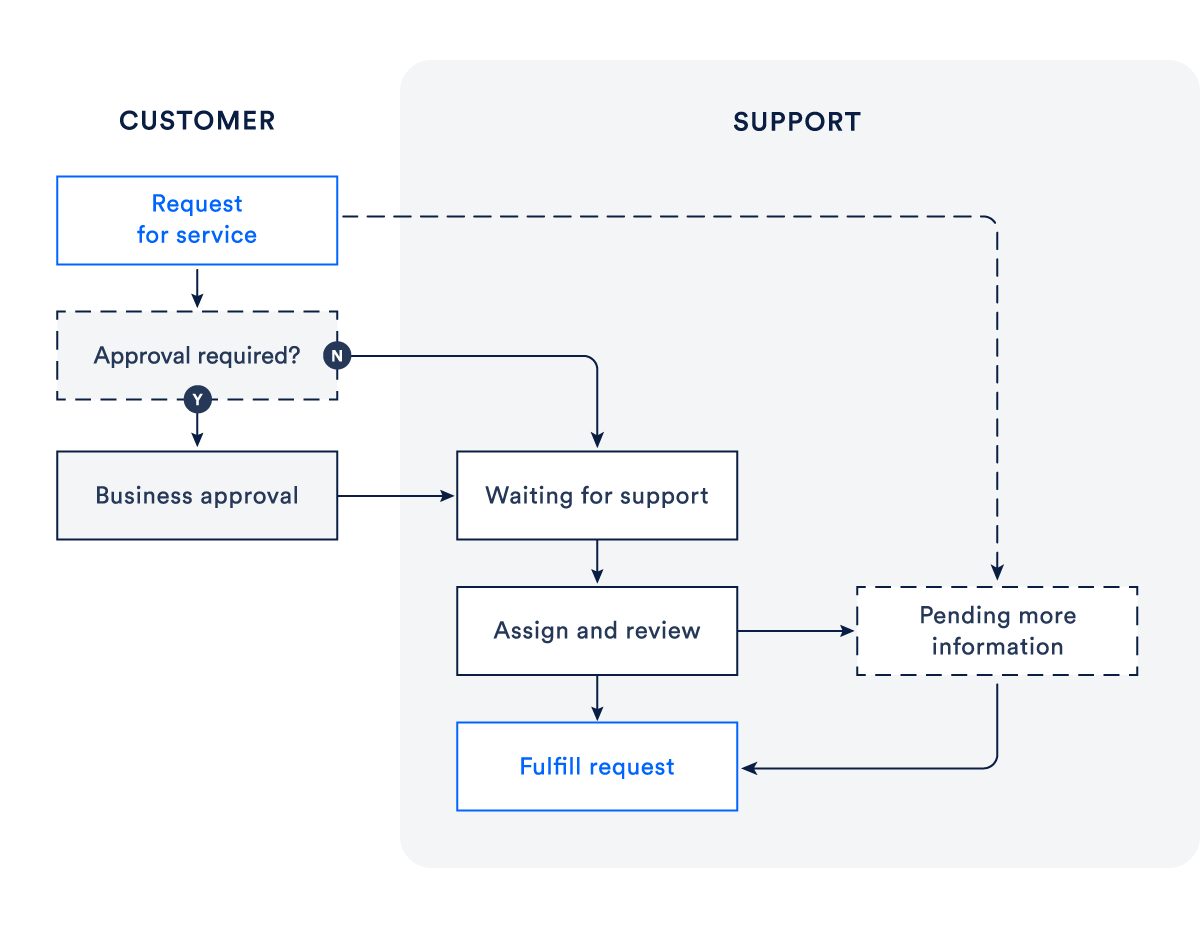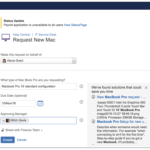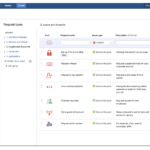Best practices for service request management
A few weeks ago we kicked off the ITSM bootcamp with an overview of the Atlassian approach to ITSM. Over the next few weeks, we’ll be walking you through the four core IT processes: service request management, incident management, problem management and change management, with a few other ITSM surprises thrown in. To keep updated on all things ITSM, subscribe to the ITSM bootcamp.

Service request management
What is a service request?
IT teams receive a wide variety of requests from customers including access to applications, software enhancements, computer upgrades and new mobile phones. The Information Technology Infrastructure Library (ITIL) classifies these types of requests as a ‘request for service’ and identifies the process to handle service requests as ‘request fulfillment’. Many service requests are recurring, so to achieve the greatest efficiency, a repeatable process and procedure should be defined.
What is request fulfillment?
Request fulfillment is the process of resolving a customer’s request for service and is managed by the service desk team whose mission is to fulfill the request while delivering the highest level of service support quality to customer (and keeping them happy!) In an organization where large numbers of service requests have to be handled, it’s recommended to handle service requests as a completely separate work stream – and to record and manage them as a separate record type.
Recap: What are the 4 core IT processes?:
- Service Request Management – A formal request from a user for something to be provided e.g. ‘I need a new Macbook for dev work.’
- Incident Management – An unplanned interruption to an IT service or reduction in the service quality e.g. ‘The website is down!’
- Problem Management – Eliminate recurring incidents & minimize incidents that cannot be prevented e.g. ‘That reporting application issue is back!’
- Change Management – Standardized method to control changes to IT system to minimize the the impact on services e.g. ‘Database upgrade is now complete’.
Service request management priorities
For IT teams, requests for services often exceed the supply of available time and resources for most IT organizations. IT service teams in large corporations are constantly responding to requests from the business, often falling into the mode of reacting first to the customers who make the most noise. Meanwhile, customers complain that IT is difficult to work with, unresponsive, and takes too long to fulfill the requests they need to do their job. Service request management makes it easy to ask for help with simple self service, provide answers with knowledge base suggestions and streamline request fulfillment to deliver optimum service. In light of that, there are a few things that IT service teams should be prioritizing.
Top 5 things to prioritize to deliver optimum service
- Think customer first – Service Desk teams can often be driven by supply rather than demand. Are you creating a service request catalog and self-service facility because you think it’s a good thing to do or are you working with your customers to meet greatest needs? Many organizations have created a service request catalog and self-service portal only for usage to be low. Learn from their mistakes, and create something based on demand not supply.
- Focus on popular requests – Service Desk teams can either start wide and shallow or narrow and deep. Understand what will suit the organization’s – and customer’s – needs best. It’s common practice to start with a subset of popular services or offerings and to ramp up from there based on usage and feedback. Try not to stretch the team too far initially and remember that a failed launch will make it even harder to get customers to return for a second attempt to encourage usage.
- Integrate knowledge – Customers are looking for answers so provide them with easy access to knowledge base and deflect tickets with searchable knowledge base articles. Deliver a self-service experience employees will love while making it easy for them to ask for help and find answers.
- Centralize the self-service portal – Customers want a single place to go for help so even if you build the most powerful self-service system, it’s worthless if customers can’t easily find it. You should work towards a goal of centralization to increase the value customers find when use the service catalog.
- Leverage automation – Deploying a highly-functional, knowledge centric Service Management solution is a great first step but you need to find ways your IT team can ‘shift left’ to deliver even greater value to customers with self-service, and the power to do this is found in automation. When you incorporate automation into your self-service capability you reduce the overall workload for your IT team by removing common repetitive tasks.
Service request management fulfillment process
While there are some variations in the way a service request is captured and fulfilled, it’s important to focus on ways to drive standardization to improve the overall service quality and efficiency. The following process represents a simple request fulfillment process based on ITIL recommendations which can be used as a starting point for adapting existing ITIL processes or defining new ones.

The service request fulfillment process, in brief:
- A customer requests help from your service catalog or via email.
- The service desk team assesses the request alongside pre-defined approval and qualification processes. If needed, they send the request for financial or business approval.
- A service desk agent works to fulfill the service request, or forwards the request to someone who can.
- After resolving the request, the service desk closes the ticket. The agent consults the customer to make sure they are satisfied.
Service request management best practices
So what does it take to create an actionable service catalog and an efficient request fulfillment process? We’ve listed some considerations below (PS: Jira Service Desk provides a fantastic way for IT teams to quickly deploy a service request catalog.)
8 tips to consider when defining service requests
- Begin with the most commonly requested items and choose ones that are simple and easily fulfilled. This delivers immediate value to customers and allows the IT service desk team to learn as they build out future phases of the request catalog.
- Document all service request offering’s requirements (question data, approval process, fulfillment procedures, fulfillment team, process owner, SLAs, reporting, etc.) before you add them to the request catalog. This will allow the IT team to best manage the request offering over time. This step is very important for more complex request offerings that will evolve over time.
- Capture the data needed to start the request process, but don’t overload the customer with too many questions.
- Standardize the approval process where possible. For example, all requests for new monitors are considered pre-approved, and all software requests need to be approved by the customers’ manager.
- Review the request fulfillment process and procedures to identify which support teams are responsible for completing the request, and if any special requirements exist.
- Identify what knowledge information should be available in the knowledge base when a request offering is released. The overall goal of self-service is to give your customers what they want faster and to deflect requests where possible, so if you can answer a question in a common FAQ, include this knowledge as a part of the plan when creating the service request offering.
- Review Service Level Agreements (SLAs) to ensure you have the proper measurements and notifications in place so that requests are fulfilled in a timely manner.
- Identify what reporting is needed to properly manage the lifecycle of a service request and request offering in the catalog in the long term.
Service request management with Jira Service Desk
Jira Service Desk is at the very heart of the Atlassian approach to ITSM. Powered by the Jira platform, Jira Service Desk is purpose built for IT teams and is the most collaborative service desk on the market. So why use Jira Service Desk for service request management?
Easy-to-use customer portal
Customers want a single place to go for help and an easy-to-use customer portal. Jira Service Desk projects come with a customizable customer-facing site (what we call the customer portal) where service desk customers can easily submit and track requests. Even better, customer portals for multiple service desk projects can be accessed from a single global help center. With one URL, customers can quickly search to find the right service desk to address their issue, see popular service desks and their recent requests.
Smart knowledge base
Customers rely on search to find answers and information in their daily lives and they expect the same from the self-service that the IT team provides. Jira Service Desk is designed around search, leveraging machine learning technology called Smart-Graph that remembers what customers are searching for and what they choose. The more customers search in the portal, the better the results become, and Jira Service Desk automatically returns results for knowledge base articles and request types that best match previous search history.
Confluence is the best way to build team knowledge and Jira Service Desk connects seamlessly with Confluence to put that knowledge to work. Answers to common questions can be put into an FAQ or How-to style article so customers can access that information directly in the customer portal when they search. The articles appear as recommendations while the customer fills out the request so they can self-serve easy requests (meanwhile deflecting support tickets).
Easy request form and approval process
Jira Service Desk also makes it super simple for customers to submit requests with a no fuss request form, which can be customized depending on the request type. Customers also have access to their requests from the portal where they read updates and communicate with the support team with additional information or questions.
The customer portal is also where approvers gain access to the requests they’ve been asked to approve. Jira Service Desk also makes it very easy to implement request approvals to enforce the request process and business rules. The approver can view the request, ask for additional information and select approve or decline to move the request forward to the appropriate Jira workflow step.
Faster service request fulfillment
The intuitive interface of Jira Service Desk makes IT service teams more productive when responding to service requests. The SLAs tell them what’s most important and what requires their immediate attention. They also have access to knowledge base articles directly in the requests so they can share articles with the customer or reference an internal article that helps them fulfill the service request. IT teams love the power of collaboration that Jira Service Desk offers, allowing them to simply @mention a member on the team to quickly bring them into the support request when needed. Jira Service Desk also provides a streamlined path to success with simple service request catalog administration. It’s easy to add new request offerings to the catalogs as “Request Types”.
Take the Jira Service Desk Tour
- Global help center
- Customer portal
- Customer portal with KB
- Knowledge Base Article
- Submitting service request
- See all service requests
- Request approval
- Request fulfillment
- Service Catalog Administration
Service request management makes it easy to ask for help with simple self service, provides answers with knowledge base suggestions and streamlines request fulfillment to deliver optimum service. Jira Service Desk provides the fastest path to deploying a service catalog that delivers immediate value to an organization on day one.
Want to keep updated on these blogs and more ITSM content? Subscribe to the ITSM Bootcamp to get best practices, tips and resources delivered directly to your inbox. Ready to jump straight into Jira Service Desk? Hit the big green button below.
Happy ITSM bootcamping. 🙂










